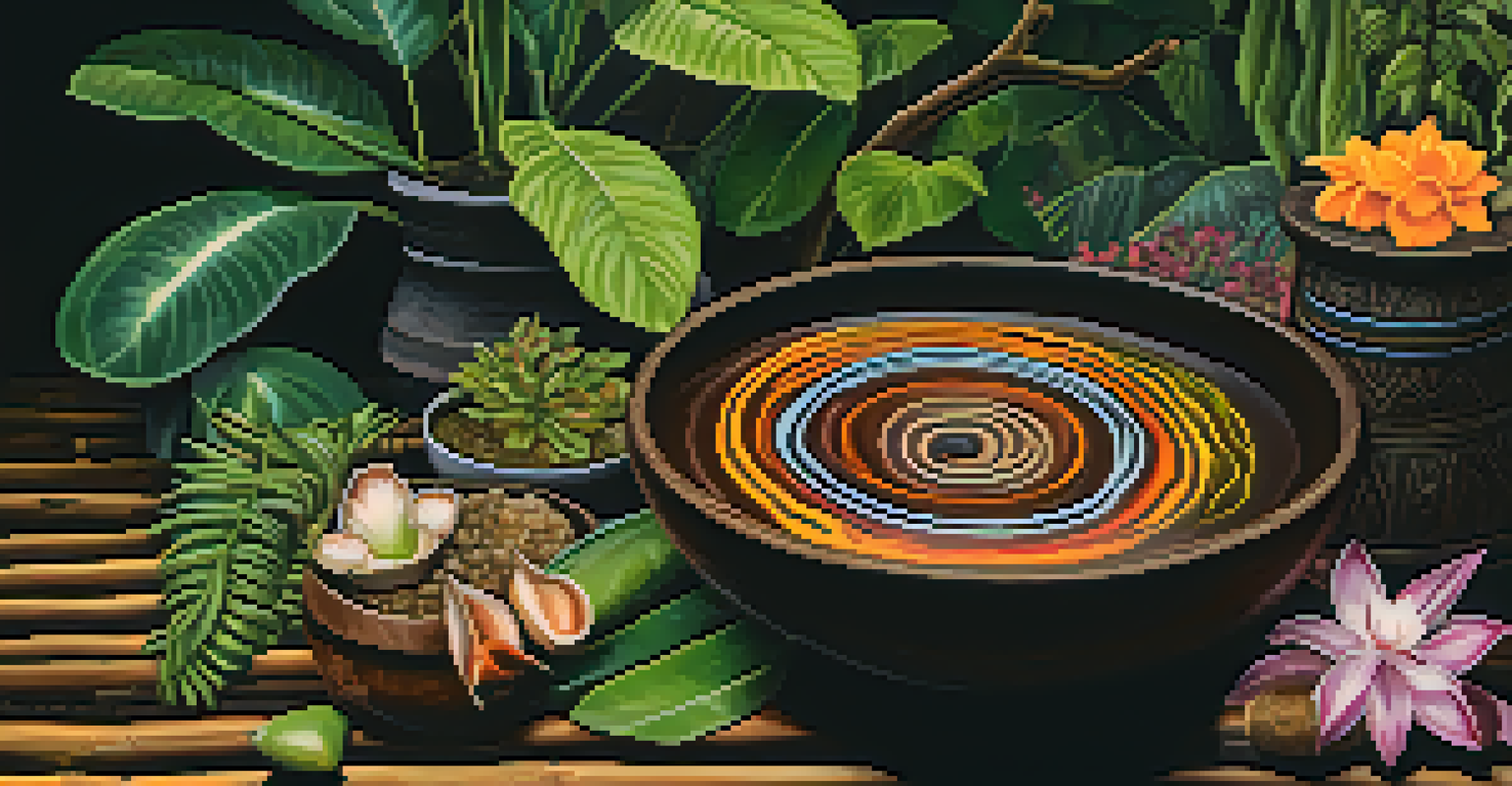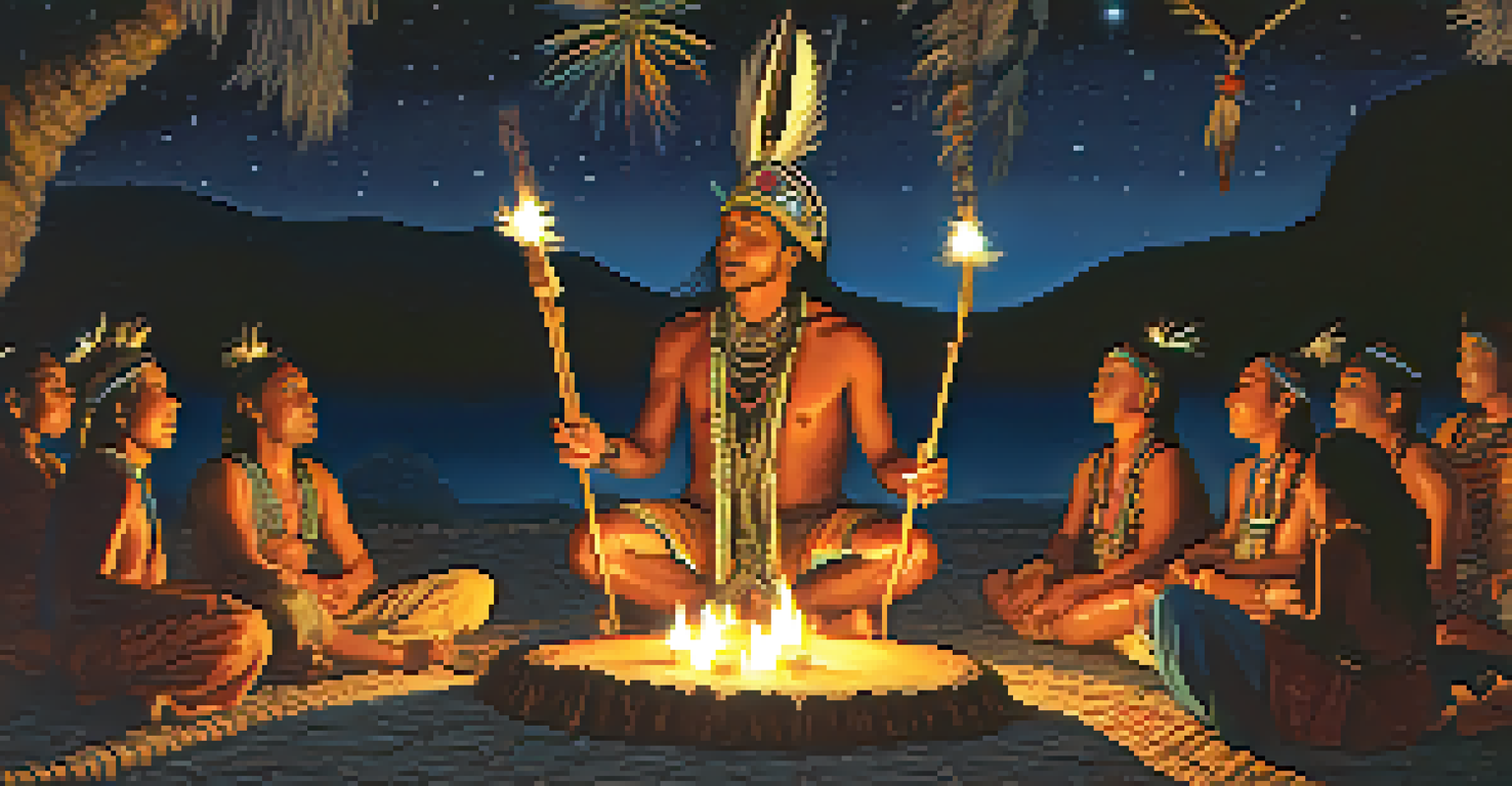Ayahuasca: Myths and Spiritual Journeys in Peru

Understanding Ayahuasca: A Brief Overview
Ayahuasca is a traditional Amazonian brew made from two plants: the Banisteriopsis caapi vine and the Psychotria viridis leaf. This powerful mixture has been used for centuries by indigenous tribes for spiritual and healing purposes. The brew is known for its psychoactive properties, primarily due to the presence of DMT, a compound that induces intense visionary experiences.
Ayahuasca is not a drug; it is a teacher that can show us the depths of our own consciousness.
Many people seek Ayahuasca for various reasons, including personal growth, healing trauma, or simply to explore their spirituality. It’s often consumed in a ceremonial context, guided by experienced shamans who help participants navigate their journeys. These rituals can be transformative, offering insights that resonate long after the experience.
Despite its growing popularity outside of indigenous cultures, it’s essential to approach Ayahuasca with respect and understanding. Many misconceptions surround it, making it crucial to differentiate between myth and reality before embarking on a journey.
Common Myths Surrounding Ayahuasca
One prevalent myth is that Ayahuasca is merely a recreational drug. In reality, it holds deep cultural significance and is used for ceremonial purposes rather than casual use. Participants often report profound emotional and spiritual revelations rather than mere intoxication.

Another misconception is that Ayahuasca is entirely safe for everyone. While many people have positive experiences, it can pose risks, especially for those with certain medical conditions or mental health issues. Understanding the potential dangers is crucial before participating in a ceremony.
Ayahuasca's Healing Journey
Ayahuasca is a traditional brew used for spiritual growth and healing, often guided by experienced shamans.
Lastly, some believe that Ayahuasca guarantees a specific outcome or vision. However, each experience is unique, shaped by the participant's mindset and intentions. This unpredictability is part of what makes the journey so rich and meaningful.
The Role of Shamans in Ayahuasca Ceremonies
Shamans play a pivotal role in Ayahuasca ceremonies, often serving as guides who facilitate the experience. Their extensive training and deep connection to the spiritual realm allow them to navigate the complexities of each journey. Many shamans have spent years learning from their elders and honing their skills.
The experience of Ayahuasca is a journey into the self, where healing and transformation can occur.
During the ceremony, shamans sing Icaros—traditional songs that are believed to help participants connect with the spirit of the medicine. These songs can evoke powerful emotions and often guide individuals through their visions, making the shaman's presence invaluable.
Choosing a reputable shaman is critical for a safe and meaningful experience. Participants should do their research, ask questions, and trust their instincts when selecting someone to guide them through their Ayahuasca journey.
Preparing for an Ayahuasca Journey
Preparation is key to maximizing the Ayahuasca experience. Many facilitators recommend following a specific diet leading up to the ceremony, which helps cleanse the body and mind. This often includes avoiding certain foods, alcohol, and even sexual activity to ensure participants are in the best possible state.
Mental and emotional readiness are just as important as physical preparation. Reflecting on personal intentions and being open to whatever arises during the experience can lead to deeper insights. Journaling or meditating before the ceremony can help clarify these intentions.
Myths vs. Reality of Ayahuasca
Common misconceptions about Ayahuasca include viewing it as a recreational drug and believing it guarantees specific outcomes.
It’s also wise to speak with people who have previously participated in ceremonies. Hearing firsthand accounts can provide invaluable insights and help set realistic expectations for what lies ahead.
Experiencing Ayahuasca: What to Expect
During an Ayahuasca ceremony, participants typically consume the brew in a sacred setting, often surrounded by others seeking similar experiences. The effects usually begin within 30 to 60 minutes and can last for several hours. Many report a range of sensations, from intense visuals to deep emotional releases.
The experience can vary widely, with some participants encountering challenging emotions or memories, while others feel a sense of bliss and connection to the universe. This duality is part of the process, as confronting discomfort can lead to significant healing and understanding.
It’s essential to remember that each journey is personal. There’s no right or wrong way to experience Ayahuasca, and trusting the process can often lead to the most profound insights.
Post-Ceremony Integration: Moving Forward
After an Ayahuasca journey, participants often find themselves in need of integration—making sense of their experiences and applying insights to everyday life. This process can be as crucial as the ceremony itself, as it helps individuals ground their revelations in reality.
Many choose to engage in integration circles or work with therapists familiar with Ayahuasca experiences. These spaces allow for sharing insights and receiving support from others who have undergone similar journeys, creating a sense of community.
Post-Ceremony Integration Matters
Integration after an Ayahuasca experience is crucial for making sense of insights and applying them to everyday life.
Journaling can also be a powerful tool during this time. Writing about the experience can help clarify feelings and reinforce the lessons learned, making it easier to navigate life post-ceremony.
Cultural Context: Ayahuasca in Indigenous Traditions
Ayahuasca is deeply rooted in the cultural practices of various Amazonian tribes, where it is used not only for healing but also for connecting with ancestral spirits. These indigenous groups view the brew as a sacred gift from the earth, essential for maintaining harmony within their communities.
In these traditions, the shaman acts as a mediator between the physical and spiritual worlds, using Ayahuasca to gain insights for healing individuals and guiding community decisions. This holistic approach emphasizes the interconnectedness of all beings and the importance of respecting nature.

As Ayahuasca gains popularity worldwide, it’s vital to honor its origins and the wisdom of the indigenous cultures that have preserved these practices for generations. Engaging with the brew should be done with respect and gratitude for its profound significance.